Advertisement
A project in Mass. tests a future for gas utilities without fossil fuels
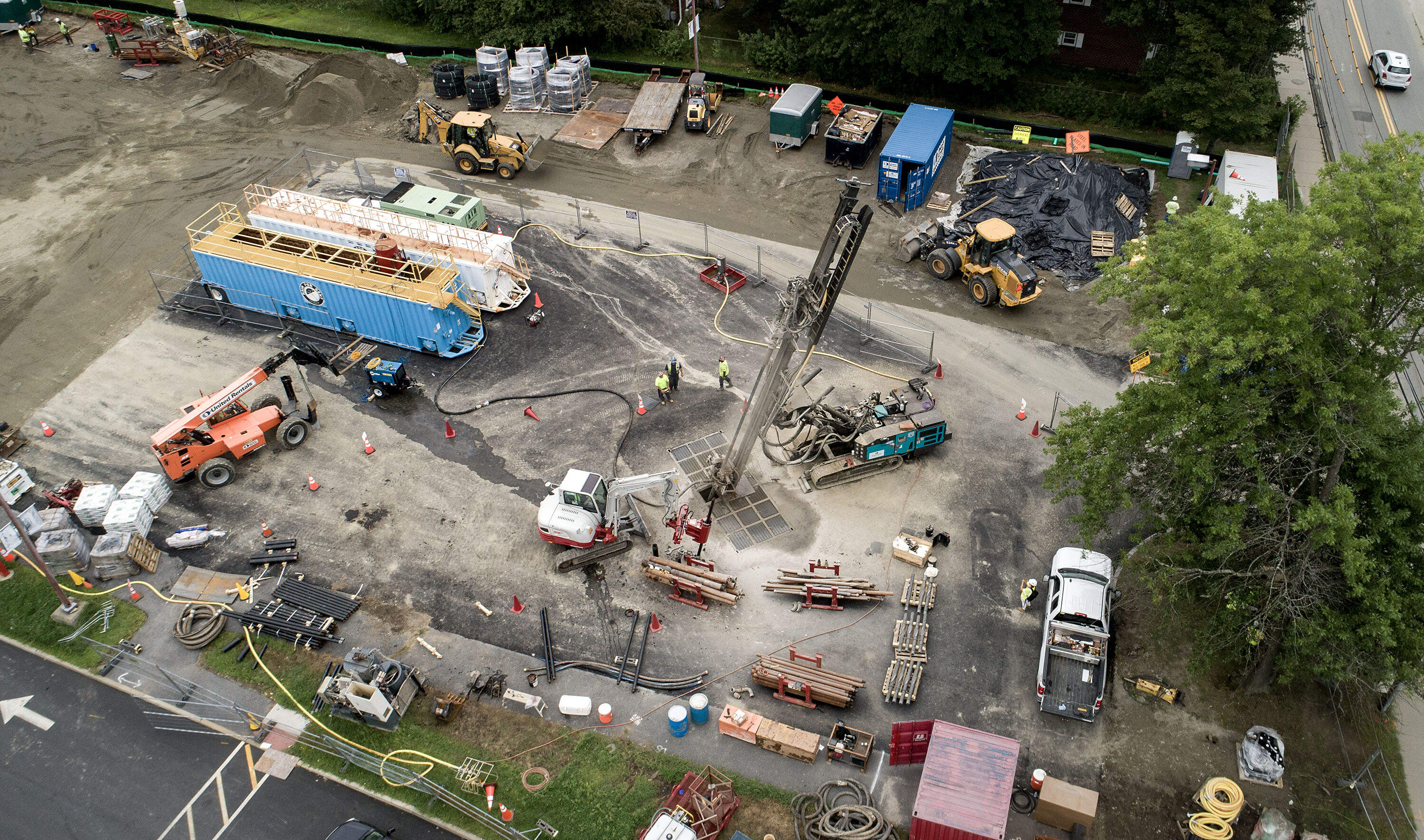
On a warm morning last August, a small crew of construction workers drove a 30-foot-tall drill through the surface of a parking lot in Framingham. As the drill bit, which was cooled by a steady stream of water, broke through the asphalt and ground through the rocky subsurface, it sent a stream of mud spewing from the hole.
Shouting over the noise, Eric Bosworth, a senior program manager in Eversource’s clean technologies department, said the drill would eventually bore 650 feet into the earth.
"This is just like drilling a water well," he said. "The only difference is they’re doing it at an angle."
Over the course of several months, Eversource workers would dig 88 holes at the site as part of a groundbreaking clean energy pilot project known as a “networked geothermal system.” When the system is up and running later this spring, it will deliver climate-friendly heating and cooling to 37 residential and commercial buildings in the area.
While this technology isn’t new, this is the first time a gas company is building one. And if it’s financially and logistically successful, environmentalists hope it can provide a business model for other utilities to wean themselves off of fossil fuels.
The pilot will run for two years, and Eversource predicts it will reduce customer utility bills and slash carbon emissions.
To understand how a networked geothermal system works, it helps to think of the earth as a big thermal battery. A few hundred feet below ground, the temperature is a constant 55 degrees Fahrenheit. By drilling down to that depth and looping water-filled pipes through the holes, Eversource can pull heat from the ground to warm buildings in the winter, and send heat back below the ground for cooling in the summer.
“At a very high level, this system is basically just a series of pipes and holes that’ll be used to move heat energy around the neighborhood,” Bosworth said.
Advertisement
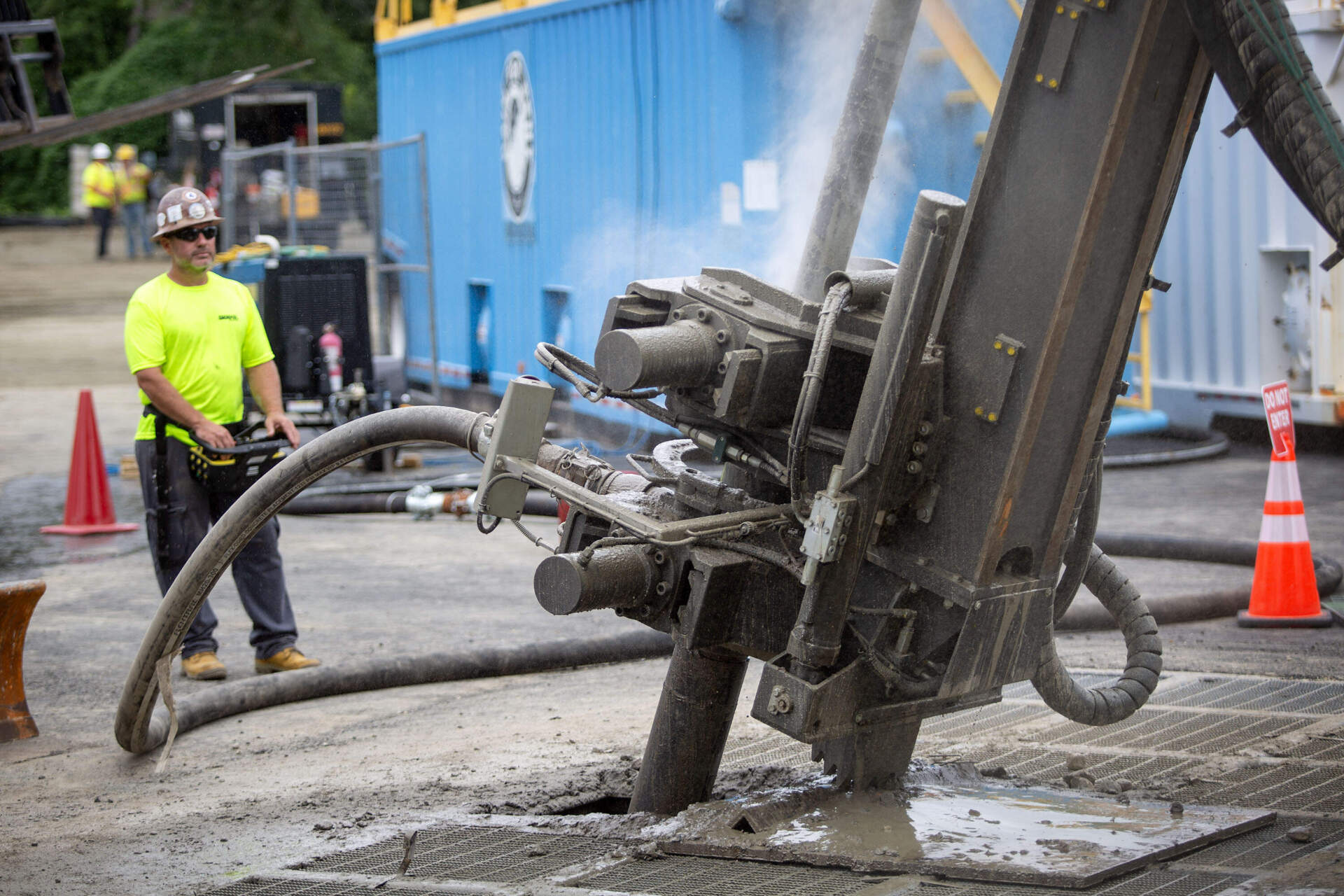
The magic ingredient to this is an appliance called a geothermal — or ground-source — heat pump, which runs on electricity and uses condensers and pumps to move heat around. Your window air conditioning unit and refrigerator are heat pumps, for instance.
But unlike those appliances, which exchange heat with the surrounding air, a geothermal heat pump extracts or deposits heat into the ground. They use far less energy than traditional fossil fuel or electric options, making them the most efficient technology on the market to heat and cool buildings.
Geothermal heat pumps can be used in individual buildings, such as a home or school, or they can be connected — “networked” — together by underground pipes, which is what Eversource is doing. When this happens, they become even more efficient and reliable because the buildings in the network can actually share heat too.
“Framingham was perfect for this [system] because we have commercial buildings nearby, a school nearby. We have residents. They can all connect together and share load and it allows for extremely efficient system,” Bosworth said. He added that the system is designed to be expanded, meaning that in the future, more buildings could be added to the network.
A new business model for gas utilities
There are several networked geothermal systems around the country, mostly on college campuses or in new housing developments. But a gas utility building one is a new frontier — and one with wide-reaching implications for the clean energy transition.
“It's a powerful story: a gas utility building a transition off gas,” said Zeyneb Magavi, a scientist and co-executive director of HEET, a Boston-based nonprofit climate solutions incubator.
Magavi and her colleague Audrey Schulman came up with the idea of the “gas to geo evolution” several years ago after Magavi realized how expensive it would be to install a geothermal heat pump in her home — just drilling the borehole in her backyard could cost upwards of $40,000, she said.
The high price tag got her thinking. What if she could get her utility to build the system? In fact, what if she could get her utility to build a whole network of geothermal heat pumps for the neighborhood?
“By going to a utility scale, we can cover the costs of the infrastructure and the transition to this safer form of heating and cooling without leaving anyone behind,” she said. It’s “an opportunity that actually is win-win” for utilities and our climate goals.
HEET pitched the idea to Eversource in 2017 and executives there immediately recognized the potential opportunity. In a state like Massachusetts that’s phasing out fossil fuels to tackle climate change, networked geothermal systems give gas utilities like Eversource a growth opportunity and place in the clean energy transition.
That's because there’s a lot of overlap between building and operating a networked geothermal system and a natural gas pipeline system. Gas utilities are already pros are digging holes and laying pipes. Plus, they own a lot of underground right-of-ways and have the ability to spread the costs of an expensive project over several decades, which allows everyone to access energy at a relatively affordable price.
The Framingham project has people at Eversource thinking differently about the company, said Nikki Bruno, the utility's vice president of clean technologies.
“We [started] saying, ‘Hey, geez, we're a thermal utility.’ We don't just do gas, we do other things as well,” she said. “We’re setting ourselves up so we can manage how we get to the future.”
Utility-led networked geothermal could also help the state manage the transition to the clean energy future. Currently, buildings emit about 35% of planet-warming emissions in Massachusetts, primarily through fossil-fuel based heating systems. By 2050, the state’s climate plan calls for eliminating nearly all emissions from residential and commercial buildings.
Meeting this target will require the widespread deployment of heap pumps — which won't be easy or cheap. But Bruno said utilities are in a unique position to help convert entire neighborhoods to cleaner heating sources at once, potentially speeding up the work while also ensuring that low-income residents aren’t the only ones left relying on an aging gas pipeline system that’s increasingly expensive to maintain.
Networked geothermal, Bruno of Eversource emphasized, is a clean energy and environmental justice strategy.
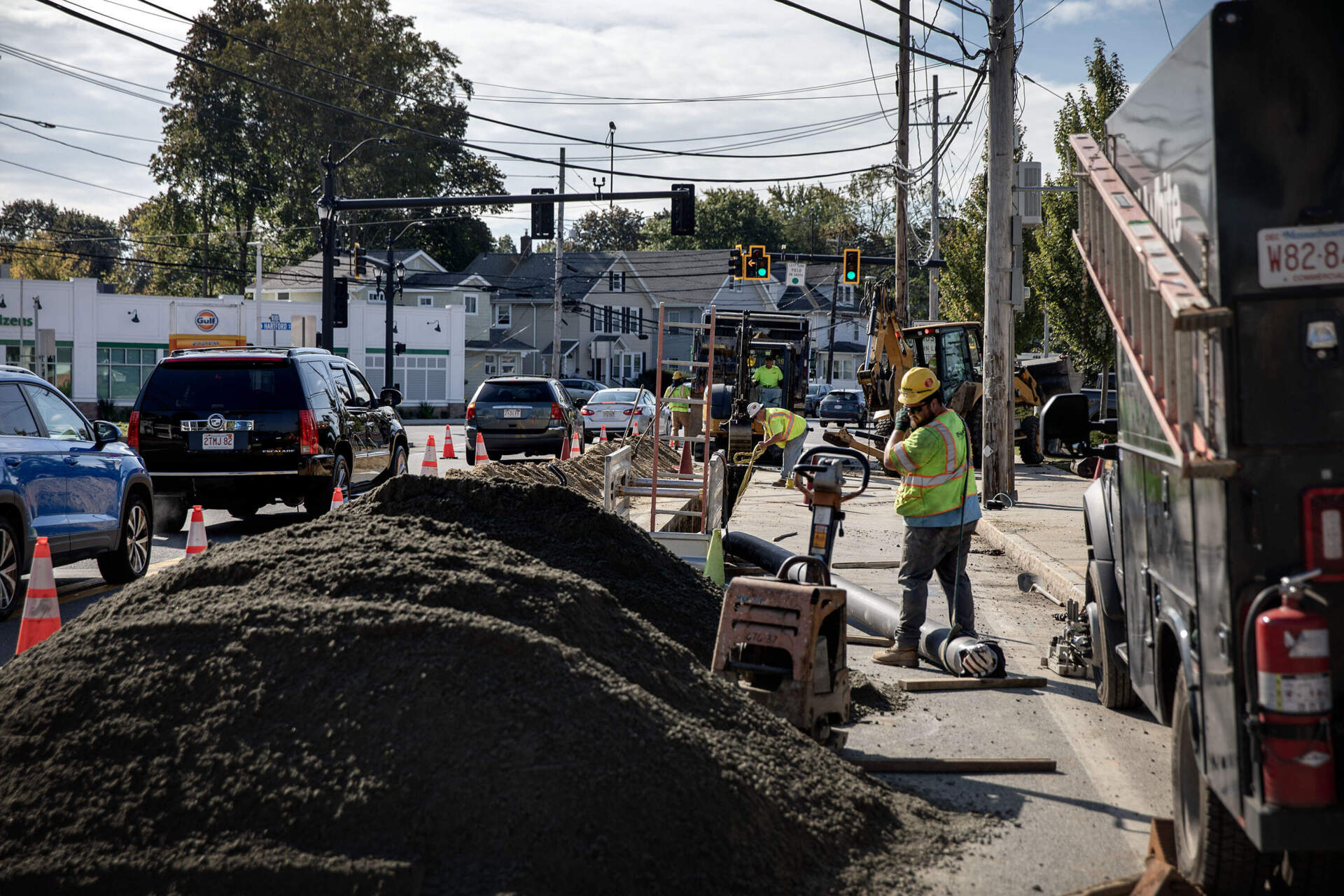
Still, natural gas utilities can’t just build networked geothermal systems whenever they want. Their legal mandate is to provide natural gas, so delivering a different source of energy requires state permission.
In Massachusetts, that approval came in 2021, when the Department of Public Utilities issued an order allowing them to pursue pilot programs. In addition to Eversource’s project in Framingham, National Grid is working on pilots in Lowell and Boston. Others are likely to follow.
The concept is spreading beyond Massachusetts, too. To date, three other states — New York, Colorado and Minnesota — have also allowed or required their gas utilities to pilot projects. Many more states are likely to do the same this legislative session. (In some states, like New York, utilities are able to pilot a variety of so-called “thermal energy networks.” These projects could include networked geothermal systems, but they could also be designed to exchange heat with other things, like a body of water or an underground subway system.)
“There are seeds of a new energy system growing across the country,” Magavi said.
A 'no-brainer' for some gas utilities
When Morgan Hood, manager of innovative products and services at VGS, a gas utility in Vermont, learned about Eversource’s pilot in Framingham a few years ago, she started to get really excited. The company was already exploring low-carbon ways to diversify its offerings, like helping customers install heat pumps and increase energy efficiency. Networked geothermal sounded like another great option to pursue.
“The business model, the financial model, the scalability is huge,” she said. “It seems like a no-brainer to me.”
Then, one day, she ended up talking to a woman at NW Natural, a gas utility in Oregon, who was also interested in the opportunities networked geothermal projects could afford her company. It felt like kismet.
“It was at that moment where we realized that we were two separate utilities but we had such such similar goals, and we had such similar — and relatively steep — learning curves ahead of us,” Hood said.
The two wondered if other gas utilities were interested — or at least curious — about networked geothermal, and in 2022, they launched the Utility Networked Geothermal Collaborative to help utilities share information, evaluate business models and discuss state policies and pilot projects.
Hood said she expected a handful of utilities to join, but the group quickly grew to 23 gas utility members, including some big companies like Avangrid, Southern Company and Dominion Energy.
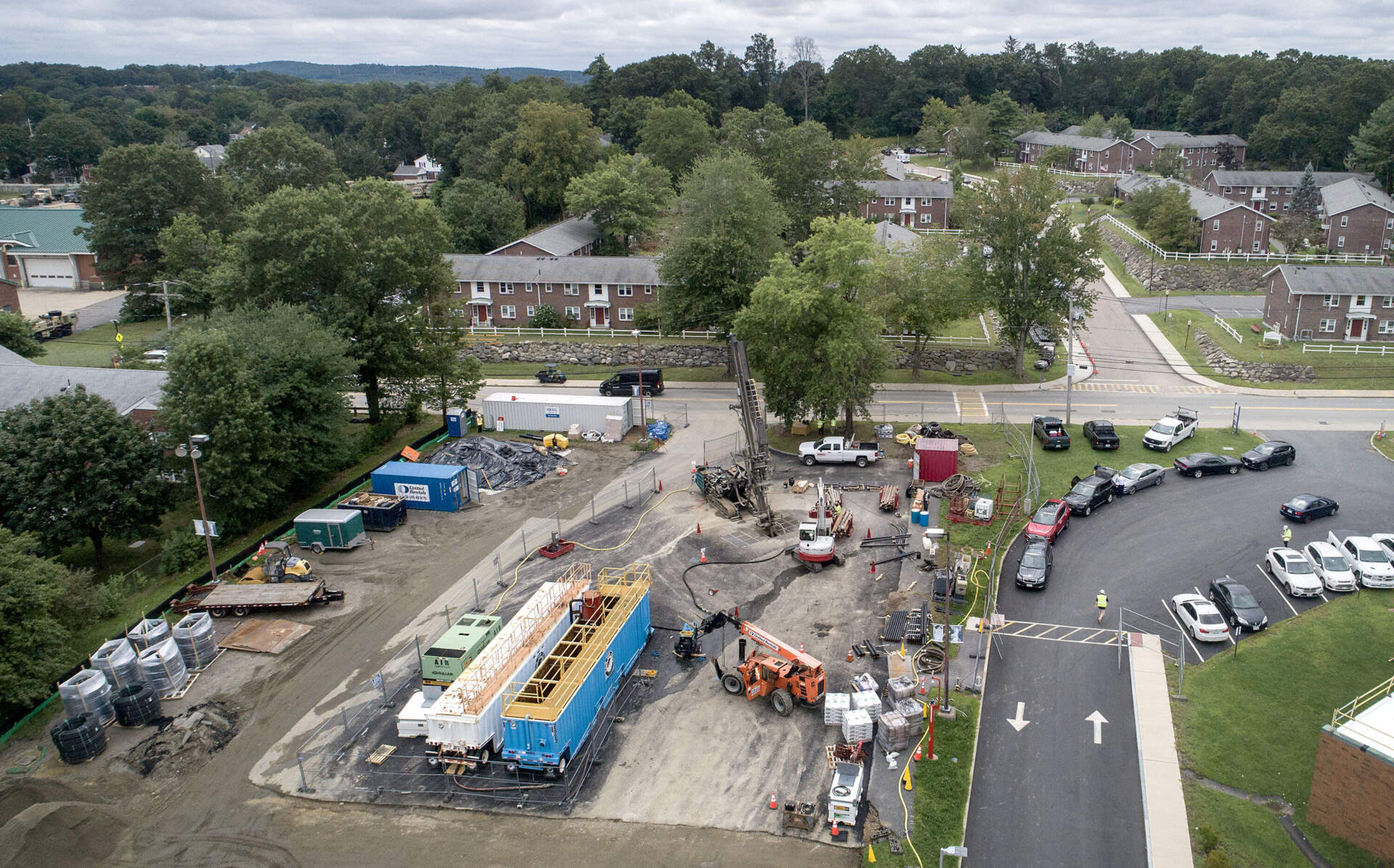
None of this is to say that gas utilities are ready to throw away their current business model and go all renewable — in fact, Hood said there are plenty of utilities out there who have no interest in geothermal technology and plan to double-down on natural gas.
Still, for many environmentalists, the fact that some gas industry players are discussing networked geothermal is heartening. Across the country, various gas companies have fought against building electrification policy.
“I think it’s an incredible opportunity,” said Nicole Abene, senior legislative and regulatory manager for New York at the Building Decarbonization Coalition, an environmental non-profit focused on making buildings more climate friendly. “It gets us to a decarbonized future while keeping jobs, [promoting] environmental justice and making sure that utilities can still operate.”
Reducing demand on the grid
As cities and states across the country work to slash carbon emission by “electrifying everything” — homes, vehicles, industry — networked geothermal projects offer another really important benefit: They will dramatically reduce the amount of new electrical infrastructure the country needs to meet this demand.
Last year, the U.S. Department of Energy released a report which found that by 2050, wide-scale deployment of geothermal heat pumps could eliminate the need for up to 43,000 miles of high-voltage transmission lines and 410 gigawatts of electrical generation. (For context, the U.S. had about 1,160 gigawatts of utility-scale generation capacity in 2022.)
Building fewer power lines and massive renewable projects like wind and solar farms saves everyone money and could mean less headache — and controversy — over where to site infrastructure. What’s more, a critical mass of home and business owners switching to geothermal heat pumps could prevent seven gigatons of carbon from being released into the atmosphere by mid-century.
These numbers are impressive, and they don’t even take into account the extra efficiencies and savings of a network of geothermal heat pumps, said Sean Porse, the data modeling analysis program manager at the Department of Energy's geothermal technologies office.
“Thermal energy networks offer an amazing opportunity to decarbonize, and ease our pathway to achieving a decarbonized grid,” he said.
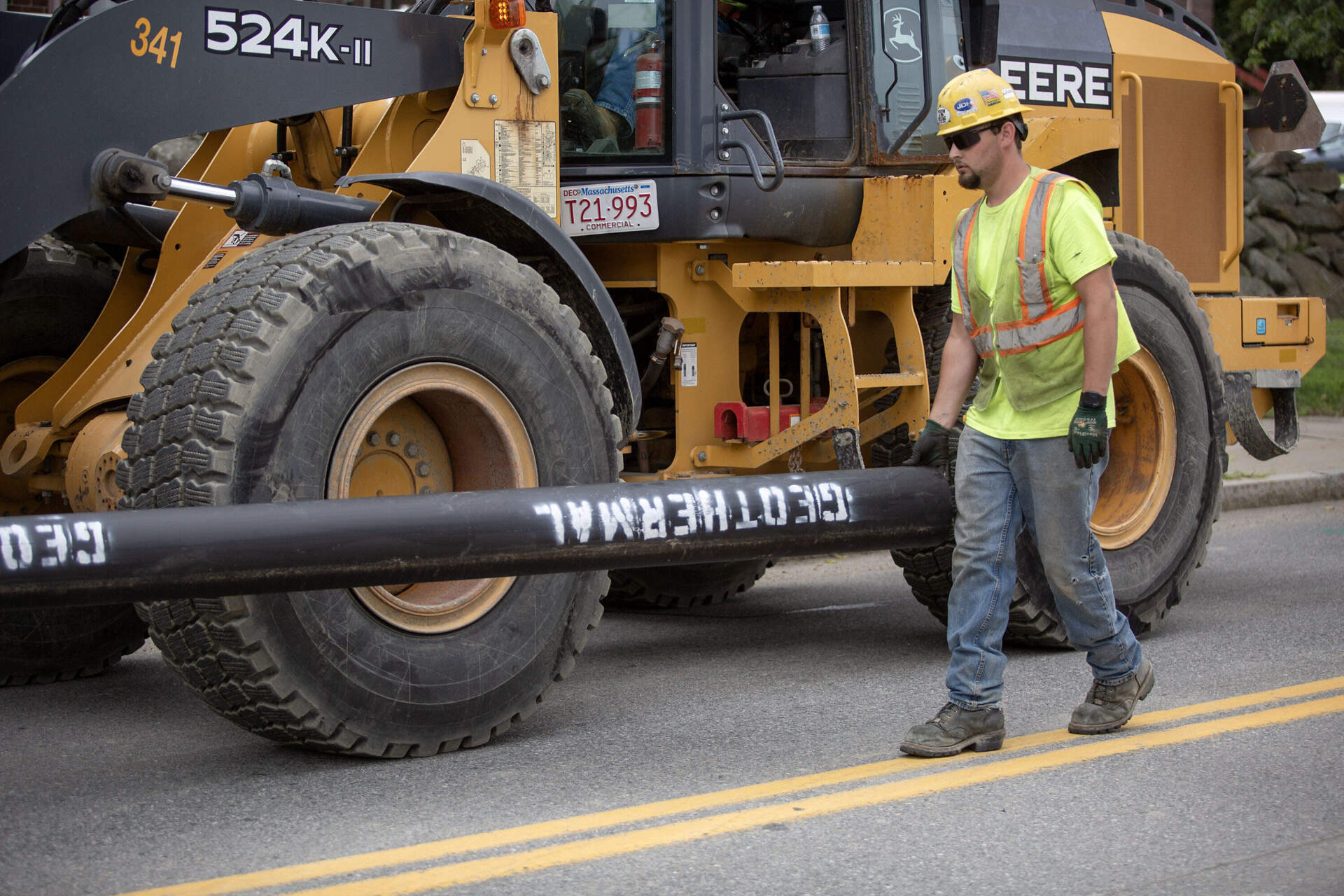
Networked geothermal projects won't work everywhere; there are some places in the country where it wouldn’t make sense to build a network, like rural communities or areas with permafrost. Despite no formal studies regarding scalability, several experts argue that, in general, anywhere it makes financial sense to connect homes to natural gas pipelines likely has the right density and ground conditions for networked geothermal.
Pilot projects like the one in Framingham will help the industry figure out what it costs to build these systems in various locations and how feasible they are to scale, said Amanda Kolker, the National Renewable Energy Lab’s laboratory program manager for geothermal.
“We have a lot of models and theories telling us what this is going to do. But how does it actually work in practice, right? The cost and performance data are going to be key,” she said.
As Eversource prepares to launch the Framingham pilot project later this spring, it’s not an understatement to say that many in the energy world — scientists, environmentalists, state officials and, of course, other utilities — are watching closely to see how it plays out.
This segment aired on March 8, 2024.

